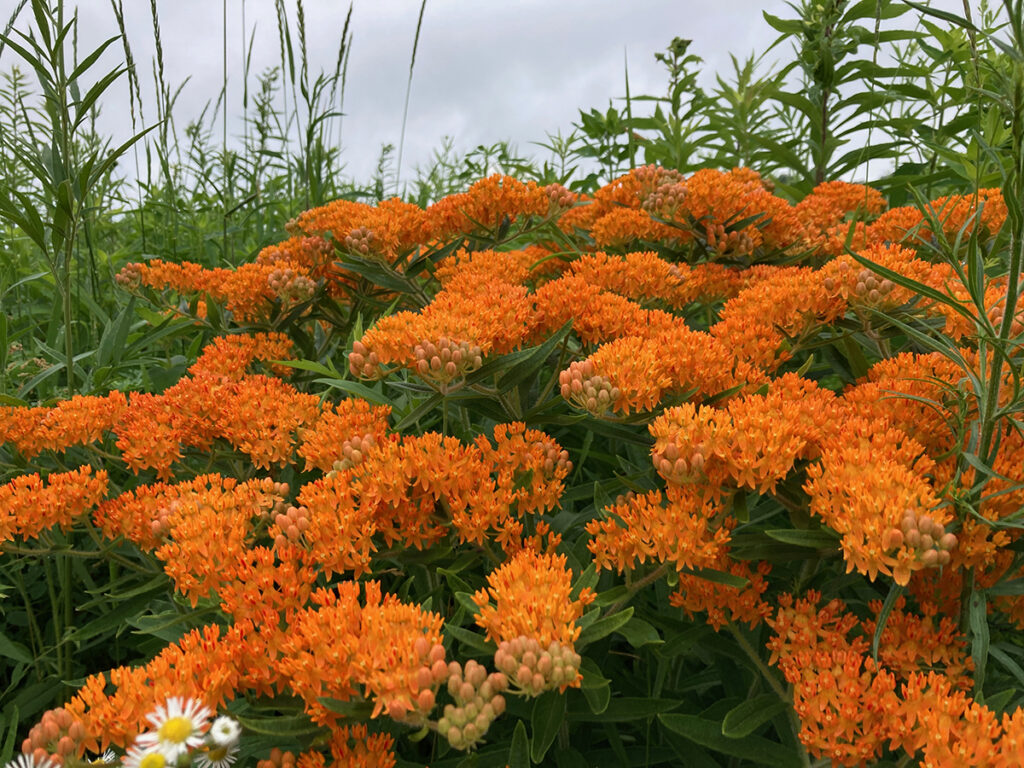The best place to experience July in Illinois is a pathway that winds through a prairie. The forest pathways have had their quick burst of spring, and now are slumbering through a shady respite. They will have their season of splendor again as autumn turns the now green canopy into a palette envious of any artist. July is the season of sunshine, warmth, prairie flowers and insects. As you find a trail through a local prairie, you become immersed in a landscape full of life and wonder.
Various species of milkweeds have already started blooming but are still hanging on with fragrant flowers that attract numerous bees and butterflies. As the prairie path winds along the edge of a woods, the Purple Milkweed (Asclepias purpurascens) is the first to bloom with vibrant flowers. It is now producing smooth seed pods in the dappled sunlight at the edge of the prairie. As you walk out into the full sun away from the trees, you come across the ubiquitous Common Milkweed (Asclepias syriaca). This steadfast native of sunny areas is full of lilac-pink, ball-shaped inflorescences. It is already producing it’s numerous curved and bumpy seed pods. As you get further out into the prairie, where the rich topsoil is deepest, you get to another milkweed that resembles the Common Milkweed, but its individual flowers are larger, and the number of inflorescences are fewer per plant. The leaves are also waxy and smooth, without the fuzzy undersides of the leaves of its more common cousin. Above is the Prairie Milkweed (Asclepias sullivantii). When you see this plant, you know you are in an ancient prairie. It is a difficult one to cultivate and has a hard time producing seed without the proper insects visiting its flowers. Finally, your trail takes you past a floral thundercloud of orange. Butterfly Milkweed (Asclepias tuberosa) is in its last glory of bloom.
As you admire the various milkweeds, you become aware that you are not alone. Bumble Bees of various shapes and sizes, beetles, and wasps all clamor over the blooms. As you watch a particular wasp, it appears that its foot is caught in one of the flowers. It struggles free, and you notice a strange object attached to the foot of the tiny insect. A small yellowish saddlebag shaped pollinia is about to get a free ride across the prairie. Most flowers produce a powdery pollen that insects seek out and collect willingly. The milkweeds have a different method. They lure the insects with a promise of nectar. Even to a human, the sweet aroma of the Common Milkweed is an irresistible scent. As the insects belly up to the nectar bar, their feet slip into funnel shaped horns of the hourglass shaped flowers. This is where the male part of the flower, the pollinia, resides. It’s shape locks around the “ankles” of the insect like a bracelet. As the insect barhops from one nectar source to another, it inadvertently spreads pollen amongst plants. This prairie has many unique ways of surviving.
Beyond the buzzing of bees, there is the flutter of butterflies. Numerous colorful angels of various size, shape, and agility all visit this prairie. They also spread the pollen of our milkweeds, but some of them expect something in return besides a sweet treat. You notice several leaves of our milkweed have semi-circular cutouts along the leaf margins. The Monarch butterfly has been here and deposited eggs upon the milkweed. The larvae hatch and begin to consume the milkweed leaves. As they eat, they separate out the toxins present in the leaves of the milkweed and store it within their bodies. This ensures that they will be unpalatable to the birds that flit about the prairie. They are the third generation of caterpillars since their seasonal ancestors flew north from their hibernation in the mountains of Mexico. This caterpillar will grow and transform itself into a butterfly that will fly towards Canada. If it is very lucky, it will lay eggs that will produce another generation that will be specifically built to make an incredible return trip all the way back to Mexico where its great-great-great grandparent once waited out the winter.
Each day you visit this prairie with open eyes, you discover more of its secrets. You can walk every day along this same pathway and are guaranteed of seeing something new. July is a peak of activity. Find your path and open your eyes to new discoveries.



1 comment for “Nature Rambles: Irresistibly radiant fragrance of flowers from milkweeds sure sign of early summer season”